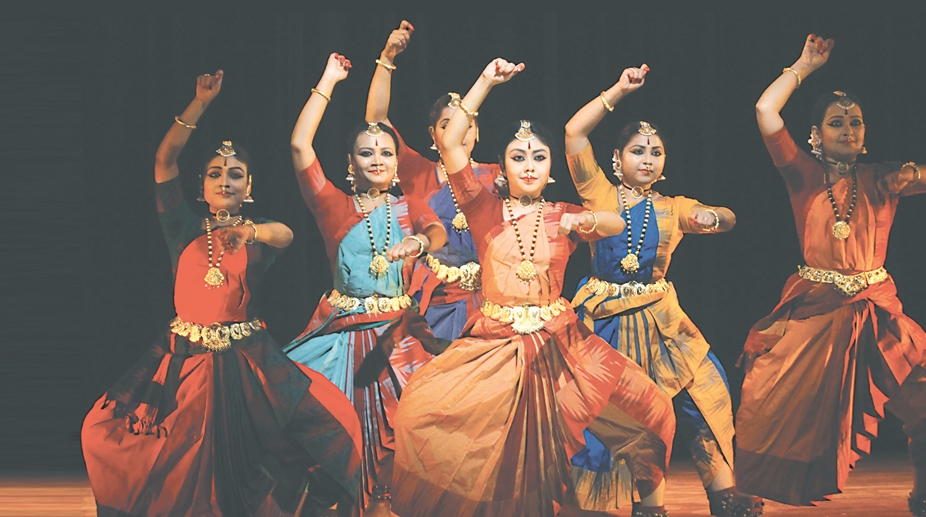Who was Saroja Vaidyanathan? Bharatanatyam dancer dies at 86
Renowned Bharatanatyam dancer Saroja Vaidyanathan passed away at her home early on Thursday, after bravely battling cancer. She had celebrated…
Bharatanatyam exponent Rajdeep Banerjee and his disciples presented a brilliant production at ICCR in Kolkata

Bharatanatyam
Rajdeep Benerjee, the architect of Granthan, presented Parampara recently at Satyajit Ray Auditorium, ICCR Kolkata. In the light of India’s great past, Granthan showcased Bharatanatyam in its evolved form in the modern age.
The sun and its appearance and disappearance every day at dawn and dusk are an eternal mystery, though we are now aware of the scientific reasons of why it happens. It has been a subject matter of great interest to dance composers and performers of every form from time immemorial. While remaining rooted to his genre, Banerjee’s presentation of Surya Aradhana (A Prayer to the Sun) showed sparks of his creativity. With this piece he started his evening of dance at ICCR and followed it up with Tana Varnam and Meenakshi Mudam Dehi. As a grand finale he performed Tillana.
Through Surya Aradhana the performers had begun with their reverential genuflection to Surya and had beautifully mingled it with a pushpanjali (flower offering) and alarippu, which itself means “to bloom”. The presentation of the invocatory piece was aimed at finding spiritual salvation and union with the Almighty. The Tana Varnam, Gananayaka Varanamukha in raga Sunadavinodini attempted to interweave symmetry into an apparently asymmetrical framework of sur (tune) and taalam (rhythm).
Advertisement
Poets have taken their liberty to brilliantly describe beautiful eyes with much imagery. Lotus-eyed or almond-shaped are some of the popular phrases. Devi of Madurai — the consort of Sundarar — has been named Meenakshi, because of her beautiful fish-shaped eyes. In Sanskrit the word meen means fish. Many a lyric has described Meenakshi’s beauty. The sage poet Muthuswami Dikshitar who lived in the 17th century wrote this verse paying his eulogy to Meenakshi of Madurai in Sanskrit just before leaving this world. Meenakshi Mudam Dehi, one of the greatest creationS of the composer is in raga Poorvi Kalyani and taal aadi. It is a brilliant piece of work, which essentially describes the beauty of the green-hued Goddess Meenakshi at Madurai.
The varnam piece divided into three parts starts with the line, Meenakshi Mudam Dehi Meekangi Raja Matangi in the Pallavi. Dikshitar directly addresses the Goddess and begs her to give him bliss. He describes her as the one who wears meckangi or golden ornaments and the one who exists as Raja Matangi. The verses that follow soon after describe her as the one who possesses all knowledge and the ultimate truth.
In the last part which is Charanam, Dikshitar sings that she is the one who dwells in Madurapuri, the one whose beautiful face outshines the moon and the one who is victorious.
The most remarkable feature of Banerjee’s presentation was that all the pieces were strung together without any pause. All the pieces followed one after the other without a break or unnecessary long drawn announcements to break their lyrical beauty. Both solo as well as group pieces were interwoven in the same dance. Banerjee rendered the solo parts in a group dance, where his co-group dancers were all his students. The nuances of Bharatanatyam were followed to the last detail.
Tillana, which is one of the most rhythmic pieces in Carnatic music, is very popular with dance composers and is performed in Margam recital before the Mangalam. Tillana, which is known for its pure dance and intricate rhythmic quality, rounded off the evening. Banerjee had chosen to compose a Tillana piece based on Raag Desh that was sung in praise of Kartikeya who rides the peacock. Kartikeya, the brother of Ganesha, is worshipped in Tamil Nadu as Lord Muruga, the God of War. That was demonstrated on the basis of Lakshana Prabandha or musical concepts that have filtered down from aeons, portraying eternal beauty.
Performers of Granthan, who made their mentor proud were Barnali Ghoshal, Mousumi Sil, Lisa Chatterjee, Satarupa Gon, Sayani Chakraborty, Aharna Chatterjee, Mousumi Dutta, Tanya Banerjee, Adrija Goswami, Mahua Singha Roy, Gargi Roy Chowdhury and Rittick Bhattacharya. Choreography and concept was of course Banerjee’s.
At the outset there was a power-point presentation, which was promotional in nature, showcasing the kind of aesthetic training that is imparted at the institute. Banerjee, the artistic director schooled in Kalakshetra style of Bharatanatyam under his teacher Ambali Praharaj, was later to hone his skills from mentor Ganga Thambi of Chennai and by constantly attending workshops of Bharatanatyam exponent CV Chandrasekhar. He is surely playing his part in spreading the country’s soft power in the eastern region.
Advertisement